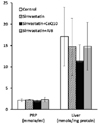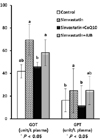1. King DE, Mainous AG 3rd, Egan BM, Player M, Geesey ME. Use of statins and blood pressure. Am J Hypertens. 2007. 20:937–941.

2. Matsuno H, Takei M, Hayashi H, Nakajima K, Ishisaki A, Kozawa O. Simvastatin enhances the regeneration of endothelial cells via VEGF secretion in injured arteries. J Cardiovasc Pharmacol. 2004. 43:333–340.

3. Susic D, Varagic J, Ahn J, Slama M, Frohlich ED. Beneficial pleiotropic vascular effects of rosuvastatin in two hypertensive models. J Am Coll Cardiol. 2003. 42:1091–1097.

4. Staal A, Frith JC, French MH, Swartz J, Güngör T, Harrity TW, Tamasi J, Rogers MJ, Feyen JH. The ability of statins to inhibit bone resorption is directly related to their inhibitory effect on HMG-CoA reductase activity. J Bone Miner Res. 2003. 18:88–96.

5. Petanceska SS, DeRosa S, Olm V, Diaz N, Sharma A, Thomas-Bryant T, Duff K, Pappolla M, Refolo LM. Statin therapy for Alzheimer's disease: will it work? J Mol Neurosci. 2002. 19:155–161.
6. Kaneta S, Satoh K, Kano S, Kanda M, Ichihara K. All hydrophobic HMG-CoA reductase inhibitors induce apoptotic death in rat pulmonary vein endothelial cells. Atherosclerosis. 2003. 170:237–243.

7. Littarru GP, Langsjoen P. Coenzyme Q10 and statins: biochemical and clinical implications. Mitochondrion. 2007. 7:Suppl. S168–S174.

8. Nawarskas JJ. HMG-CoA reductase inhibitors and coenzyme Q10. Cardiol Rev. 2005. 13:76–79.

9. Lamperti C, Naini AB, Lucchini V, Prelle A, Bresolin N, Moggio M, Sciacco M, Kaufmann P, DiMauro S. Muscle coenzyme Q10 level in statin-related myopathy. Arch Neurol. 2005. 62:1709–1712.

10. Dhanasekaran M, Ren J. The emerging role of coenzyme Q-10 in aging, neurodegeneration, cardiovascular disease, cancer and diabetes mellitus. Curr Neurovasc Res. 2005. 2:447–459.

11. Kamzalov S, Sumien N, Forster MJ, Sohal RS. Coenzyme Q intake elevates the mitochondrial and tissue levels of coenzyme Q and alpha-tocopherol in young mice. J Nutr. 2003. 133:3175–3180.

12. Maroz A, Anderson RF, Smith RA, Murphy MP. Reactivity of ubiquinone and ubiquinol with superoxide and the hydroperoxyl radical: implications for in vivo antioxidant activity. Free Radic Biol Med. 2009. 46:105–109.

13. López-Lluch G, Barroso MP, Martín SF, Fernández-Ayala DJ, Gómez-Díaz C, Villalba JM, Navas P. Role of plasma membrane coenzyme Q on the regulation of apoptosis. Biofactors. 1999. 9:171–177.

14. Ryszawa N, Kawczyńska-Drózdz A, Pryjma J, Czesnikiewicz-Guzik M, Adamek-Guzik T, Naruszewicz M, Korbut R, Guzik TJ. Effects of novel plant antioxidants on platelet superoxide production and aggregation in atherosclerosis. J Physiol Pharmacol. 2006. 57:611–626.
15. Sobotková A, Másová-Chrastinová L, Suttnar J, Stikarová J, Májek P, Reicheltová Z, Kotlín R, Weisel JW, Malý M, Dyr JE. Antioxidants change platelet responses to various stimulating events. Free Radic Biol Med. 2009. 47:1707–1714.

16. Merlo Pich M, Castagnoli A, Biondi A, Bernacchia A, Tazzari PL, D'Aurelio M, Parenti Castelli G, Formiggini G, Conte R, Bovina C, Lenaz G. Ubiquinol and a coenzyme Q reducing system protect platelet mitochondrial function of transfusional buffy coats from oxidative stress. Free Radic Res. 2002. 36:429–436.

17. Luzak B, Boncler M, Rywaniak J, Wilk R, Stanczyk L, Czyz M, Rysz J, Watala C. The effect of a platelet cholesterol modulation on the acetylsalicylic acid-mediated blood platelet inhibition in hypercholesterolemic patients. Eur J Pharmacol. 2011. 658:91–97.

18. Uyuklu M, Meiselman HJ, Baskurt OK. Effect of decreased plasma cholesterol by atorvastatin treatment on erythrocyte mechanical properties. Clin Hemorheol Microcirc. 2007. 36:25–33.
19. Villar J, Montilla C, Muñiz-Grijalvo O, Muriana FG, Stiefel P, Ruiz-Gutiérrez V, Carneado J. Erythrocyte Na(+)-Li+ countertransport in essential hypertension: correlation with membrane lipids levels. J Hypertens. 1996. 14:969–973.
20. Lijnen P, Fenyvesi A, Bex M, Bouillon R, Amery A. Erythrocyte cation transport systems and membrane lipids in insulin-dependent diabetes. Am J Hypertens. 1993. 6:763–770.

21. Heilmann L, von Tempelhoff GF, Ulrich S. The Na+/K+ co-transport system in erythrocytes from pregnant patients. Arch Gynecol Obstet. 1993. 253:167–174.

22. Duke JA, Ayensu ES. Medicinal Plants of China. 1985. Vol 2. Algonac: Reference Publications;705S.
23. Kobayashi H, de Mejia E. The genus Ardisia: a novel source of health-promoting compounds and phytopharmaceuticals. J Ethnopharmacol. 2005. 96:347–354.

24. Jia Z, Koike K, Nikaido T, Ohmoto T, Ni M. Triterpenoid saponins from Ardisia crenata and their inhibitory activity on cAMP phosphodiesterase. Chem Pharm Bull (Tokyo). 1994. 42:2309–2314.

25. Newell AM, Yousef GG, Lila MA, Ramírez-Mares MV, de Mejia EG. Comparative in vitro bioactivities of tea extracts from six species of Ardisia and their effect on growth inhibition of HepG2 cells. J Ethnopharmacol. 2010. 130:536–544.

26. Folch J, Lees M, Sloane Stanley GH. A simple method for the isolation and purification of total lipides from animal tissues. J Biol Chem. 1957. 226:497–509.

27. Kang JS, Cregor MD, Smith JB. Effect of calcium on blood pressure, platelet aggregation and erythrocyte sodium transport in Dahl salt-sensitive rats. J Hypertens. 1990. 8:245–250.
28. Scharnagl H, Vogel M, Abletshauser C, Freisinger F, Stojakovic T, März W. Efficacy and safety of fluvastatin-extended release in hypercholesterolemic patients: morning administration is equivalent to evening administration. Cardiology. 2006. 106:241–248.

29. Saito Y, Goto Y, Dane A, Strutt K, Raza A. Randomized dose-response study of rosuvastatin in Japanese patients with hypercholesterolemia. J Atheroscler Thromb. 2003. 10:329–336.

30. Galus R, Włodarski P, Włodarski K. Influence of fluvastatin on bone formation induced by demineralized bone matrix in mice. Pharmacol Rep. 2006. 58:443–447.
31. Davis HR Jr, Pula KK, Alton KB, Burrier RE, Watkins RW. The synergistic hypocholesterolemic activity of the potent cholesterol absorption inhibitor, ezetimibe, in combination with 3-hydroxy-3-methylglutaryl coenzyme a reductase inhibitors in dogs. Metabolism. 2001. 50:1234–1241.

32. Sawada M, Matsuo M, Seki J. Inhibition of cholesterol synthesis causes both hypercholesterolemia and hypocholesterolemia in hamsters. Biol Pharm Bull. 2002. 25:1577–1582.

33. Kim JL, Chae IS, Kang YH, Kang JS. Effect of onion and beet on plasma and liver lipids, platelet aggregation, and erythrocyte Na efflux in simvastatin treated hypercholesterolmic rats. Nutr Res Pract. 2008. 2:211–217.

34. Kim YH, Moon YI, Kang YH, Kang JS. Effect of coenzyme Q10 and green tea on plasma and liver lipids, platelet aggregation, TBARS production and erythrocyte Na leak in simvastatin treated hypercholesterolmic rats. Nutr Res Pract. 2007. 1:298–304.

35. Dietschy JM, Turley SD, Spady DK. Role of liver in the maintenance of cholesterol and low density lipoprotein homeostasis in different animal species, including humans. J Lipid Res. 1993. 34:1637–1659.

36. Fernandez ML. Guinea pigs as models for cholesterol and lipoprotein metabolism. J Nutr. 2001. 131:10–20.

37. Haramaki N, Ikeda H, Takenaka K, Katoh A, Sugano R, Yamagishi S, Matsuoka H, Imaizumi T. Fluvastatin alters platelet aggregability in patients with hypercholesterolemia: possible improvement of intraplatelet redox imbalance via HMG-CoA reductase. Arterioscler Thromb Vasc Biol. 2007. 27:1471–1477.

38. Chello M, Spadaccio C, Patti G, Lusini M, Barbato R, Goffredo C, Di Sciascio G, Covino E. Simvastatin reduces platelet-endocardium adhesion in atrial fibrillation. Atherosclerosis. 2008. 197:588–595.

39. Broncel M, Balcerak M, Cieślak D, Duchnowicz P, Koter-Michalak M, Sikora J, Chojnowska-Jezierska J. Effect of fluvastatin extended release on the protein-lipid structure of erythrocyte membrane and C-reactive protein in patients with hyperlipidemia. Pol Merkur Lekarski. 2007. 22:107–111.
40. Upaganlawar A, Farswan M, Rathod S, Balaraman R. Modification of biochemical parameters of gentamicin nephrotoxicity by coenzyme Q10 and green tea in rats. Indian J Exp Biol. 2006. 44:416–418.
41. Fernandez ML, Lin EC, Trejo A, McNamara DJ. Prickly pear (Opuntica sp.) pectin reverses low density lipoprotein receptor suppression induced by a hypercholesterolemic diet in guinea pigs. J Nutr. 1992. 122:2330–2334.









 PDF
PDF ePub
ePub Citation
Citation Print
Print



 XML Download
XML Download